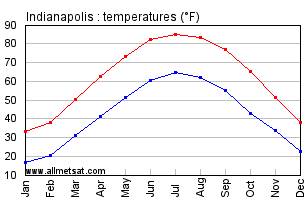Indianapolis, the capital city of Indiana, is situated in a region characterized by a continental climate. This climatic backdrop plays a crucial role in shaping the agricultural landscape of the area. The weather patterns, including temperature fluctuations, precipitation levels, and seasonal changes, significantly influence crop yields, farming practices, and overall agricultural productivity. In this article, we will explore how Indianapolis weather affects local agriculture, offering insights into the challenges and opportunities that arise from these climatic conditions.
Understanding Indianapolis Weather Patterns
The weather in Indianapolis is marked by four distinct seasons, each bringing unique challenges and advantages to local farmers. The city’s climate is defined by:
- Temperature: Winters can be cold, with average temperatures ranging from 20°F to 40°F, while summers can be hot, reaching up to 90°F and above.
- Precipitation: The region receives an average of 40 inches of rainfall annually, with the majority occurring in the spring and summer months.
- Frost Dates: The last frost typically occurs in late April, while the first frost can arrive by late October.
These weather patterns create a unique agricultural environment that requires farmers to adapt their practices accordingly.
Impact on Crop Selection and Yields
The specific weather conditions in Indianapolis directly influence the types of crops that can be successfully cultivated in the region. Farmers must select crops that are well-suited to the local climate, taking into consideration temperature, moisture levels, and the length of the growing season.
Suitable Crops for Indianapolis

Some of the primary crops grown in and around Indianapolis include:
- Corn: Corn thrives in warm temperatures and is a staple crop in Indiana, benefiting from the state’s fertile soil and favorable growing conditions.
- Soybeans: Another major crop, soybeans are well-suited to the region’s climate and are often rotated with corn to enhance soil health.
- Wheat: Winter wheat is popular due to its early planting and harvesting, which aligns well with the local climate.
- Vegetables: Farmers also grow a variety of vegetables, including tomatoes, peppers, and cucumbers, which can be sensitive to temperature fluctuations.
The success of these crops is highly contingent on weather factors, which can lead to significant variations in yield from year to year.
Case Study: The 2019 Growing Season
To illustrate the impact of weather on local agriculture, consider the 2019 growing season. Indiana experienced a particularly wet spring, with heavy rainfall leading to delayed planting and flooded fields. According to the USDA, farmers in Indiana faced a 25% reduction in corn and soybean planting compared to previous years. This situation highlights how adverse weather conditions can disrupt agricultural cycles, leading to lower yields and economic challenges for farmers.
Adapting to Climate Variability
Farmers in Indianapolis are increasingly faced with climate variability, including shifting weather patterns and unpredictable conditions. To mitigate the impacts of adverse weather, local agriculture has begun to incorporate innovative practices and technologies.
Strategies for Adaptation
Farmers are employing various strategies to adapt to changing weather conditions, including:
- Crop Rotation: Rotating crops helps maintain soil health and reduces the risk of pest infestations, allowing for better yields even in challenging weather conditions.
- Cover Cropping: Planting cover crops during the off-season helps improve soil quality, retain moisture, and prevent erosion.
- Precision Agriculture: Utilizing technology such as GPS and sensors allows farmers to monitor soil conditions and apply water and nutrients more efficiently.
- Season Extension Techniques: Techniques such as hoop houses and row covers help protect crops from late frosts and extend the growing season.
These practices not only enhance resilience but also promote sustainable farming, ensuring the long-term viability of local agriculture.
The Role of Local Institutions
Local agricultural institutions play a vital role in supporting farmers in Indianapolis by providing resources, education, and research on weather impacts and farming techniques.
Extension Services
The Purdue University Cooperative Extension Service offers valuable resources to farmers, including:
- Workshops on weather forecasting and climate adaptation strategies.
- Research on crop varieties that are more resilient to changing weather patterns.
- Soil testing and analysis to guide nutrient management practices.
By leveraging these resources, farmers can make more informed decisions, improving their chances of success in a challenging climate.
Community Support and Collaboration

Local farmers often collaborate through community-supported agriculture (CSA) programs and cooperatives. These networks provide a platform for sharing resources, information, and experiences, fostering a sense of community while enhancing resilience against weather-related challenges.
Climate Change and Future Implications

As global temperatures rise and weather patterns continue to shift, the agricultural sector in Indianapolis will face new challenges. Climate change is expected to exacerbate existing weather variability, leading to:
- Increased frequency of extreme weather events, such as droughts and heavy rainfall.
- Shifts in growing seasons, potentially impacting traditional planting and harvesting schedules.
- Greater pest and disease pressures, as warmer temperatures may favor the proliferation of certain pests.
Farmers will need to remain vigilant and proactive in adapting to these changes, utilizing innovative practices and technologies to ensure sustainability.
The weather in Indianapolis plays a pivotal role in shaping local agriculture, influencing crop selection, yields, and farming practices. Farmers must navigate the challenges of a continental climate, characterized by seasonal variations and unpredictable weather patterns. Through adaptation strategies, collaboration with local institutions, and a commitment to sustainable practices, the agricultural community in Indianapolis is working to build resilience against the impacts of weather variability and climate change. As we look to the future, continued innovation and cooperation will be essential in ensuring the viability of agriculture in this region, allowing it to thrive amid changing climatic conditions.